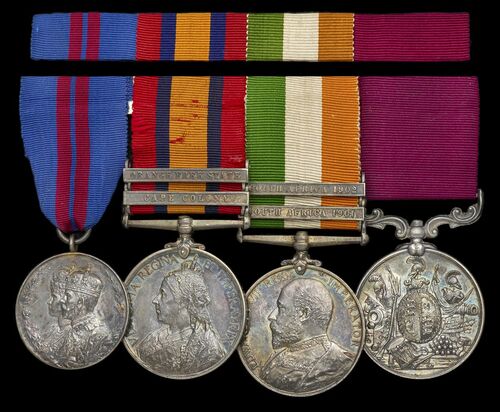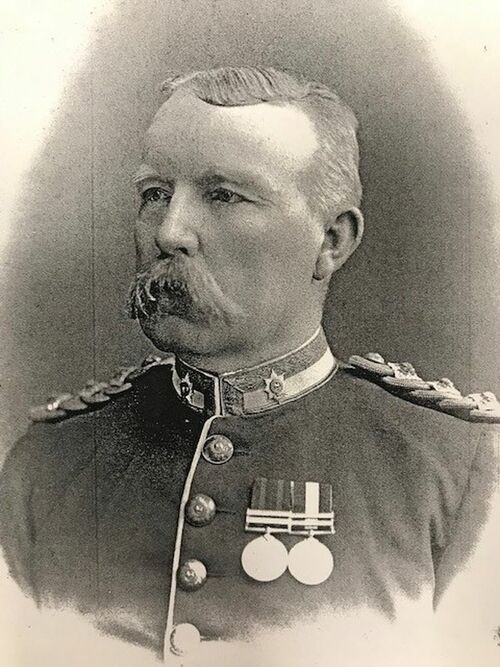Auction: 24002 - Orders, Decorations and Medals
Lot: 163
Four: Hon. Major and Quartermaster S. A. Snatt, Worcestershire Regiment, who earned a brace of 'mentions' during the Boer War
Coronation 1911; Queen's South Africa 1899-1902, 2 clasps, Cape Colony, Orange Free State (Lieut & Qr: Mr: S. A. Snatt. Worc: Rgt:); King's South Africa, 2 clasps, South Africa 1901, South Africa 1902 (Cpt. Qr. Mr. S. A. Snatt. Worc. Rgt.); Army L.S. & G.C., V.R. (769. Cr Sergt S. A. Snatt. Worc: Rgt), mounted as worn, lightly toned, good very fine (4)
M.I.D. London Gazette 10 September 1901 & 29 July 1902.
Spencer Arthur Snatt was born on 22 May 1858 at Parkhurst, Isle of Wight and was educated at the Duke of York's Royal Military School, Guston, Kent from November 1865-May 1872. On 21 May 1872, he enlisted into the 29th Foot (Worcestershire Regiment) at St George's Barracks, London at the tender age of 14 years, for a period of 12 years, as Boy No. 769.
He served at home until 28 January 1879, being made Private on 22 May 1873 and Drummer 1 November. Snatt was later promoted Lance-Corporal on 13 November 1877 and Corporal on 1 February 1878.
Leaving for India on 29 January 1879, he arrived in Bombay on 11 March. Snatt's army career continued to flourish in India, where he served at a variety of stations for over 17 years. Promotion to Lance Sergeant followed on 20 March 1879 and Sergeant on 15 November. He was promoted to Colour-Sergeant on 6 January 1885. He married Mary Anne Woodman at the Garrison Church, Karachi on 19 February 1887. They produced three children.
He was awarded his Army L.S. & G.C Medal on 15 August 1890. Snatt was promoted Quartermaster Sergeant on 3 November 1891 and Sergeant Major on 23 May 1894. On 29 June 1896, Snatt returned from India and on the next day was promoted Honorary Lieutenant and Quartermaster.
The Boer War
On 17 March 1900, the men of the 1st Battalion embarked at Southampton on the troop ship S.S. Braemar Castle and headed for the war in South Africa. On 8 April 1900, the 1st Battalion disembarked at Cape Town and then made their way north, forming part of the 17th Brigade (Major-General C. E. Boyes), 8th Division, under Lieutenant-General Sir Leslie Rendle. The Boers at this time were holding Dewetsdorp and Wepener. The Battalion concentrated at Edenburg in the southern Orange Free State on 14 April 1900 and was subsequently engaged in operations near the border with Basutoland, including the relief of Wepener and the action at Brandwater Basin.
Relief of Wepener
The plan was to relieve Wepener which was being besieged at that time and if possible, cut off the Boers as they retreated northwards. On 15 April, the Battalion made its first march from Edenburg to Riel, then on 16 April to Reddersburg and on 18 April to Rosandale where they joined up with the 3rd Division. On 19 April, Oorlogs Poort was reached and on 20 April, after a long march, the advance guard occupied the hills at Wakkerstroomwerg, where the Battalion came under fire for the first time. The Boers occupied a strong position on the hills above De Wets Dorp. The 3rd and 8th Divisions stood facing the Boers until 25 April when, after a long flank march, the 17th Brigade marched into De Wets Dorp, the Boers having evacuated their position the previous night. The advance was continued to the Modder River and to Thabanchu, which was reached on 28 April, where it remained until 18 May, when it left for Ladybrand.
The British forces pushed the Boers north. During the action around Dewetsdorp some thirty of the 1st Worcesters wandered at night into the wrong line, and were made prisoners by the Boers.
Brandwater Basin
On 5 June 1900 General Roberts marched into Pretoria, the capital of the Transvaal. Shortly afterwards the British captured Bethlehem, an important centre in the east of the Orange Free State. The Boers escaped and sought refuge in Brandwater Basin enclosed by a ring of hills lying south of Bethlehem. There were 9,000 of them hemmed in the basin by 16,000 British troops. Their leaders, President Steyn and Commandants Christian de Wet and Prinsloo, were imprisoned with them. It looked as if none could escape. There were however some passes in the mountain barrier which General Hunter, commanding the British troops, had not yet blocked and the Boers decided to quit the basin through them while there was yet time. They split into four parts, the largest under de Wet with President Steyn left on 15 July. Two more were due to go on the following day, and the fourth under Prinsloo would hold the passes open and leave last of all. De Wet's column got away, moving so quietly that they passed within a mile of the British camp without anyone knowing. The next two parties were delayed by waiting for commandos from Natal to join them and were forced back by the British who had by now plugged the passes. In the biting cold darkness the Boers became demoralised. Some tried frenziedly to get away, only to find their waggons, their guns, their animals and themselves trapped, jammed in the defiles leading to the passes. On 29 July, Prinsloo submitted to the British demand for unconditional surrender. Some managed to get away even after the capitulation, but 4,500 remained to be taken prisoner, along with 4,000 sheep and 6,000 horses. After this action the 1st Worcesters moved north-east and headed for Ladybrand.
On 2 September 1900 a commando of Free State Boers under Fourie emerged from the mountain country on the Basutoland border and attacked Ladybrand, which was held by a small garrison consisting of one company of the 1st Battalion, Worcester Regiment and forty-three men of the Wiltshire Yeomanry under Major F White, Royal Marine Light Infantry, when that town was surrounded by a force of 3000 Boers, with nine guns and two machine guns. The Boers seem to have been the same force which had been repulsed at Winburg only several days before on 24 August 1900.
Ladybrand
On 29 July, the main body of the Battalion left Ladybrand for Ficksburg, leaving H Coy and two troops of Imperial-Yeomanry in the town. On the night of 30-31 August, news was received that Fourie with between 3000 and 4000 Boers had broken through and were moving south. The O.C. at Ladybrand, Major Bulfin, knowing that the town could not be held, concentrated his force on a hill overlooking it, taking as much ammunition and stores as he could and destroying the rest. The Worcesters beat back the Boers repeated attacks and held their line at Ladybrand for the next 4 days while waiting for British reinforcement to arrive. On 5 September 1900 the Worcesters were finally relieved by Major-General Bruce Hamilton infantry of the 21st Brigade who had marched 80 miles in four and a half days. The small defending force having suffered only slight loss - an instance of the value of well-constructed intrenchments. The defence won special commendation. Rundle sent the following telegram to the Commanding Officer on their fine achievement:
'The whole Division joins me in hearty congratulations on and sincere admiration of the plucky defence made by the Worcesters and Imperial Yeomanry at Ladybrand. They have gallantly upheld your motto and set an example to the whole of us what infantry well entrenched can do against overwhelming odds. I beg you will convey the above to the officer commanding the Worcesters at Ladybrand and the Imperial Yeomanry there. I am publishing a special divisional order today with reference to the above to be read at the head of every company, troop and battery in the division. Please wire me how the wounded are doing and name of officer commanding the Company.'
The first phase of the South African War, the heavy fighting between the opposing main armies, ended in the summer of 1900 with the defeat of the Boer forces and the occupation of Pretoria, their capital, by the British army under Lord Roberts; but the Boers did not give up the struggle. Dispersed in small commandos, well-armed, highly mobile, and operating over a vast and poorly-mapped country, they maintained for another two years a fierce guerilla warfare, attaching British posts, convoys, and lines of communication. To meet these attacks the British forces were reorganized, and many battalions of Mounted Infantry were formed by taking picked men from the Line Battalions. A Worcestershire Company was formed from personnel of the 1st and 2nd Battalions of the Worcestershire Regiment, and was grouped with companies of other regiments to form the 5th Battalion of Mounted Infantry.
In October 1900 the Battalion was put into Bethlehem as garrison and at Ficksburg and the occupation of blockhouse lines in Orange River Colony, as the Free State had been renamed, but some portion was always marching and fighting to the end of the war. The 1st Battalion suffered the following casualties during the Boar War: killed in action or died of wounds, seven N.C.O.s and men; died of disease or accidentally killed, 48 N.C.O.s and men; wounded, two officers and 21 N.C.O.s and men.
For his services as a Supply and Transport Officer during the campaign, Snatt was twice 'mentioned' and further promoted Honorary Captain and Quartermaster on 22 August 1902.
Returning from South Africa on 1 April 1903, he shortly afterwards submitted a request that he be considered for the post of Quartermaster and Adjutant of the Duke of York's Military School, where he had previously been a pupil. Snatt was favourably supported by his commanding officer, but it would appear he was not granted his wish and remained with the 1st Battalion.
On 23 May 1906, he was transferred, at his own request, to the 6th (Militia) Battalion, Worcestershire Regt, then in Co. Tipperary, Ireland, as Quartermaster at Worcester. On 1 July 1911, Snatt was placed on retired pay and granted the Honorary rank of Major and Quartermaster. He was also awarded the King's 1911 Coronation Medal. In May 1913, after completing 40 years service, he retired from the Army and took up residence in The Shrubbery, Camp Hill Road, Battenhall, Worcester.
Upon the outbreak of the Great War, Snatt immediately volunteered for service with his old Regiment and on 5 August 1914 became Depot Quartermaster at Dorchester and later at Worcester. He served in this capacity seven days a week, with not a single day absent or sick until placed on retired pay in 1918, but then was almost immediately made 2nd Lt. in the Royal Air Force and as a Staff Officer Grade 3, was posted to the 24th (Operations) Group, Leeds, remaining with them until they were broken up in August 1919. Snatt had, on five separate occasions, been recommended for a step in promotion to Lieutenant-Colonel and Quartermaster, in recognition of his selfless, dedicated and effective service, but as a result of Army Regulations recently introduced, he was never awarded it. Clearly this annoyed and frustrated him intensely, which together with a discrepancy over his pension, caused him to continually write to the War Office, Government Ministers and members of the House of Lords, which he continued to do until 1931.
In 1932, Major and Mrs. Snatt went to live at Sandown, Shirley Road, Hove, Brighton. Snatt died on 15 March 1939 and was the last soldier of the 'old 29th Foot' to have crossed the bar.
Subject to 20% VAT on Buyer’s Premium. For more information please view Terms and Conditions for Buyers.
Estimate
£600 to £800
Starting price
£600







